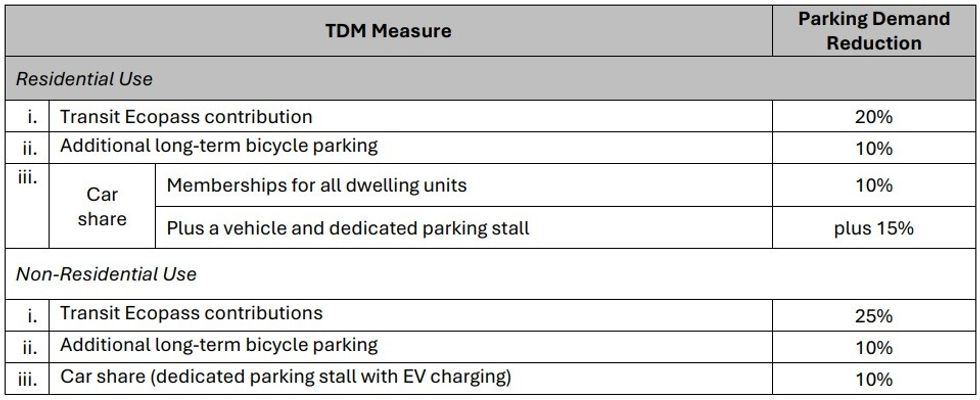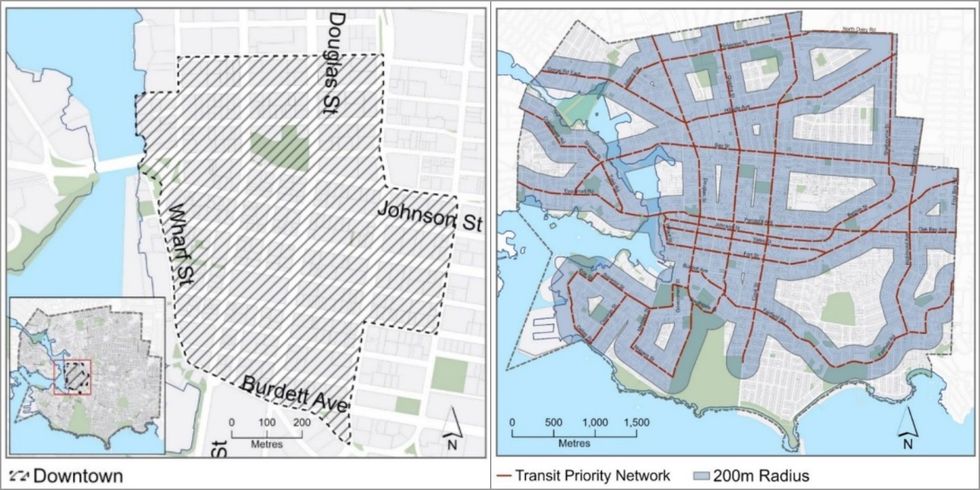Two years after signalling that it was going to make a change, the City of Victoria has unveiled a suite of changes to its parking regulations that would “shift away from the car-centric regulatory model to one that better aligns with City policy, responds to different mobility demands across specific geographic areas and addresses a more diverse range of mobility needs through a range of options.”
“The current regulatory approach for off-street parking is largely focused on the provision of motor vehicle parking, setting minimum supply rates that are based on estimated off-street parking demand,” said the City in a staff report that’s set to be received by Council later this week. “Minimum supply rates vary between geographic area (lower rates downtown and in community villages), tenure (lower rates for market rental and affordable rental housing) and unit size (larger dwelling units require more parking than smaller units).”
“This regulatory framework adds time, cost, uncertainty, and potential inconsistency to the development process if proponents seek to reduce off-street parking stall requirements,” the report continues. “In such instances, applicants are required to submit permits for variances and negotiate TDM measures with staff on a case-by-case basis. In some cases, where the size of the variance is significant, an applicant is required to provide a parking study to determine whether the amount of parking and/or TDM measures being proposed are satisfactory.”
The new proposed approach has several “key foundational elements.”
Establishing A Baseline Parking Supply Rate
According to the City, car ownership in Victoria is trending downwards, with 25% of Victoria households not owning a vehicle and 41% of households in downtown not owning a vehicle. The City has not updated its off-street minimum parking rates since 2018 and has now outlined an update to supply rates, which are expressed as the amount of parking stalls provided per residential unit, with higher rates for larger units.
The new proposed supply rates have been lowered across the board, regardless of residential type and unit size, and in some cases have been completely eliminated, such as for affordable housing. (A full list of the changes, including for non-residential uses, can be viewed here.)
Of note is that, as is the case with all minimum parking requirements, applicants can still opt to provide more parking than what is required under policy and developers do see some value in providing parking.
Proposed Residential Baseline Parking Supply Rates. / City of Victoria
Maximum Parking Supply Rates
While many municipalities across North America are focused on eliminating minimum parking requirements, some have also started to look at or introduce maximum parking requirements to prevent the possibility of parking oversupply.
“With respect to setting a maximum supply rate, it is recommended that a consistent city-wide rate be set at 10% above the baseline parking supply requirements,” said City staff in the report. “Given that the baseline rate is generally reflective of actual parking demand and developments in the City typically don’t provide more than the required number of parking stalls, it is considered that requests to provide more than 110% of the baseline will be relatively rare.”
Although the concept hasn’t quite gone mainstream yet, the City notes that maximum parking supply rates exist in the District of Saanich, City of New Westminster, and City of Kelowna.
Provision Of TDM Measures
Although municipal governments set minimum parking requirements, many have also traditionally allowed applicants to reduce the amount of parking they have to provide through transportation demand management (TDM) measures, which entails the applicant providing residents with things such as enhanced bicycle parking, subsidized transit passes, and/or car share access.
“Current processes allow applicants to apply for a parking variance where they are not satisfying minimum parking supply requirements and, in these instances, the provision of TDM measures is negotiated to provide alternative transportation options for residents,” said staff in the report. “Rather than continuing to require variances and negotiate TDM on a case-by-case basis (which adds time, cost and uncertainty to applications), it is recommended that the provision of TDM measures to offset a reduction in parking stall supply be formalized in the form of regulations. The City currently does apply a similar regulatory approach, but only with respect to the Missing Middle housing regulations.”
According to the City, the new proposed measures were developed based on a review of industry best practices and other municipalities. The City also notes that providing TDM measures instead of constructing underground parking often reduces construction costs for developers and that those cost savings could potentially be passed on to residents. (Full details of what the individual TDM measures entail are available here.)
 Transportation Demand Management Measure Options. / City of Victoria
Transportation Demand Management Measure Options. / City of Victoria
Cash-In-Lieu Of Parking
As another alternative, municipalities often also allow developers to provide cash contributions to reduce the amount of parking they have to provide. Cash secured that way must go to a reserve fund that can only be used towards things like parking infrastructure and other transportation-related infrastructure.
Victoria does not currently have a cash-in-lieu policy, but is now set to establish one, with rates the City says are in line with those in other municipalities.
The staff report also notes that similar to TDM measures, the cash-in-lieu option generally provides savings to developers compared to constructing underground parking, which could again be a benefit to residents. (A report published by the Metro Vancouver Regional District earlier this year found that constructing parking can cost over $200,000 per stall.)
No changes to requirements are being proposed for accessible and visitor parking and both are also not eligible to be reduced via TDM measures of cash-in-lieu.
 Proposed Cash-in-Lieu Rates. / City of Victoria
Proposed Cash-in-Lieu Rates. / City of Victoria
Area-Specific Regulations
The aforementioned changes are city-wide, but would be adjusted for different areas of Victoria. For example, in the downtown core, there would be no baseline parking supply rate, a maximum parking supply rate would be established, and a minimum set of TDM measures will be required.
“Due to the characteristics of the area and the relevant policy direction, it is recommended that minimum parking requirements do not apply in the downtown,” said staff. “This would allow developments to provide parking based on market demand and project considerations. Dependent on development conditions, a proponent could provide between 0% to 110% (maximum parking supply rate) of the baseline parking supply rate.”
For major mobility hubs such as the Mayfair, Midtown, Hillside, Jubilee, and Oak Bay Junction town centres, the baseline parking supply rate would be reduced by 50%, minimum TDM measures would be required to offset that reduction, additional TDM measures or cash-in-lieu would be allowed, and a maximum parking supply rate would be established.
For sites along the City’s transit priority network (TPN) and within 200 metres of the TPN, the regulations would be similar to those for major mobility hubs, except the baseline parking supply rate would be reduced by 30%.
 The downtown area (left) and transit priority network (right) that will have adjusted parking regulations. / City of Victoria
The downtown area (left) and transit priority network (right) that will have adjusted parking regulations. / City of Victoria
Other Changes
The City has also proposed changes regarding bicycle parking. To account for the increased popularity of large bicycles (such as electric or cargo bicycles), the City has proposed a requirement that 15% of all long-term and short-term bicycle parking stalls be designed to accommodate large bicycles. To ensure accessibility, the maximum percentage of long-term stalls that can be provided as wall-mounted racks would also be decreased from 50% to 30%.
A new regulation would also require 50% of all long-term bicycle stalls to support electric charging (access to a 110v charging outlet) and the City has proposed introducing requirements for end-of-trip facilities in non-residential units in order to support active transportation. Those facilities include showers, change rooms, repair equipment, and bicycle wash stations.
As it relates to electric vehicles, the City is proposing that all parking spaces be required to support EV charging, that the minimum number of parking stalls that support EV charging be increased for non-residential uses, and that new minimum parking requirements be introduced for EV charging stations for industrial, commercial, and institutional uses.
All of the above changes, as well as changes regarding a new proposed Curbside Management Strategy, are set to be considered by Council on Thursday, June 26. If endorsed by Council, staff will then work on drafting bylaw changes and holding public engagement before the changes are presented to Council at a later date for formal consideration.
